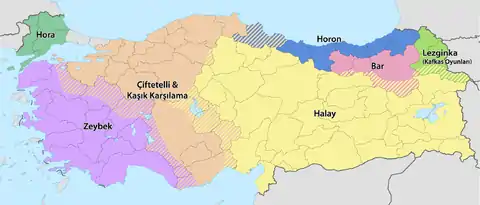

The zeybek is a form of Turkish folk dance originating from Yörüks[1] particular to Western, Central and Southern Anatolia in Turkey. It is named after the Zeybeks.
The dance is hierarchic, with a group of companions performing it while wearing a particular decorative costume and a typical headdress.[2] A Zeybek band has a leader called efe; the inexperienced young men were called kızans. The term efe is presumably the survivor of the Greek word ephebos.[2]
All zeybek dances have a common characteristic form, but the positioning of the arms and body differ according to the different regions. The rhythm is also very characteristic, a pattern of nine slow beats: 9
4 = 4 + 4 + 1 beats or 2 + 2 + 2 + 3 with occasional variations.[3]
Zeybek melodies can be divided according to their tempo: ağır (slow) and kıvrak (fast). The ağır zeybek have rhythmic patterns of 9
2 or 9
4, which begin with an introduction called gezinleme in free style where the dancers wander freely before starting to dance in time with the rhythm. There is, however, no gezinleme introduction in female zeybek dances. Kıvrak zeybek have rhythmic patterns of 9
8 or 9
16.
This dance is popular in Aydın, İzmir, and Denizli.[4]
In addition, information about the similarities of the Pecheneg costume with the Zeybek costume, as determined in the Byzantine chronicles, Claude Cahen explained this case in his article titled Battle of Manzikert According to Islamic sources, with the statements that the clothes of the paid Pecheneg soldiers under the command of Alyatte, one of the Byzantine commanders, could not be distinguished from their cognates on the opposite front. According to some historians, Pecheneg culture has a great influence on Zeybek culture.[5][6]
See also
References
- ↑ "zeybek".
- 1 2 Meriç, Recep (2017). "Dionysiac and Pyrrhic Roots and Survivals in the Zeybek Dance, Music, Costume and Rituals of Aegean Turkey". Gephyra. 14: 213–239. doi:10.37095/gephyra.318457. ISSN 1309-3924.
- ↑ Shay, Anthony (2016-10-02). Ethno Identity Dance for Sex, Fun and Profit: Staging Popular Dances Around the World. Springer. ISBN 9781137593184.
- ↑ "Folk dances of Izmir - All About Turkey". www.allaboutturkey.com. Retrieved 2017-07-05.
- ↑ Hayati Kuzucu, Türk Milli Kimliğinin Oluşması Süreci ve Yukarı Teke Örneği Bağlamında Dirmil’in Demografisi, Burdur 2017, s. 119.
- ↑ Mehmet Eröz, Milli Kültürümüz ve Meselelerimiz, Doğuş Yayın ve Dağıtım, İstanbul 1983, s. 85-86.